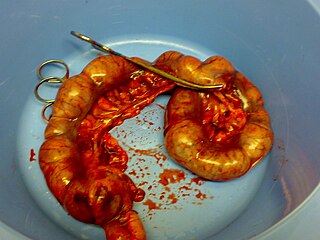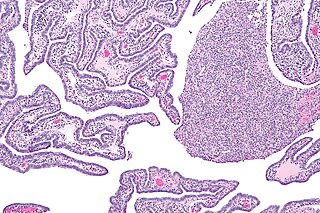
Metritis is inflammation of the wall of the uterus, whereas endometritis is inflammation of the functional lining of the uterus, called the endometrium. [1] The term pelvic inflammatory disease (PID) is often used for metritis.

Metritis is inflammation of the wall of the uterus, whereas endometritis is inflammation of the functional lining of the uterus, called the endometrium. [1] The term pelvic inflammatory disease (PID) is often used for metritis.
Postpartum metritis , also known as puerperal sepsis, occurs within 21 days and is most common within 10 days of delivery. Metritis is characterized by an enlarged uterus and a watery red-brown fluid to viscous off-white purulent uterine discharge, which often has a bad smell. The severity of disease is categorized by the signs of health:
Clinical endometritis is defined in cattle as the presence of a purulent uterine discharge detectable in the vagina 21 days or more postpartum. Simple grading systems for clinical disease are based on the character of the vaginal mucus and typical Grading schemes for clinical endometritis are widely used by veterinarians.
Subclinical endometritis is characterized by inflammation of the endometrium and the presence of neutrophils in cytology or biopsy histology, in the absence of signs of clinical endometritis.
These terms can apply to any species of mammal. Amongst domestic animals, metritis and endometritis are most common in cattle after parturition, and the diseases are often called postpartum metritis or postpartum endometritis. These diseases in cattle are caused by bacteria and occasionally viruses. The most common bacteria that cause postpartum metritis and endometritis in cattle are Escherichia coli, Trueperella (previously Arcanobacterium) pyogenes and anaerobic bacteria such as Prevotella species and Fusobacterium necrophorum. [2] The virus most consistently associated with postpartum uterine disease in cattle is Bovine Herpesvirus 4 (BoHV-4). In addition, "Several specific diseases are associated with metritis or endometritis. These include brucellosis, leptospirosis, campylobacteriosis, and trichomoniasis" [3]
In cattle, bacterial infection of the uterus affects almost all animals after parturition. This does not mean they will get disease. Beef cattle rarely have disease unless they have a predisposing factor such as retained placenta or difficult parturition. However, uterine disease is common in dairy cattle - particularly high-milk-yield cows such as Holstein-Friesian cows.
Contagious equine metritis is a sexually transmitted infection in horses, recognized since 1977.
In 2014, a study reported about the first successful vaccination trials in cattle. The infection rate declined significantly. [4]
The word metritis ( /məˈtraɪtɪs/ or /miˈtraɪtɪs/ ) uses combining forms of metr- + -itis , yielding "uterus inflammation".

Pelvic inflammatory disease, also known as pelvic inflammatory disorder (PID), is an infection of the upper part of the female reproductive system, namely the uterus, fallopian tubes, and ovaries, and inside of the pelvis. Often, there may be no symptoms. Signs and symptoms, when present, may include lower abdominal pain, vaginal discharge, fever, burning with urination, pain with sex, bleeding after sex, or irregular menstruation. Untreated PID can result in long-term complications including infertility, ectopic pregnancy, chronic pelvic pain, and cancer.

Lemierre's syndrome is infectious thrombophlebitis of the internal jugular vein. It most often develops as a complication of a bacterial sore throat infection in young, otherwise healthy adults. The thrombophlebitis is a serious condition and may lead to further systemic complications such as bacteria in the blood or septic emboli.

Fusobacterium is a genus of obligate anaerobic, Gram-negative, non-sporeforming bacteria belonging to Gracilicutes. Individual cells are slender, rod-shaped bacilli with pointed ends. Fusobacterium was discovered in 1900 by Courmont and Cade and is common in the flora of humans.

Pyometra or pyometritis is a uterine infection. Though it is most commonly known as a disease of the unaltered female dog, it is also a notable human disease. It is also seen in female cattle, horses, goats, sheep, swine, cats, rabbits, hamsters, ferrets, rats and guinea pigs. Pyometra is an important disease to be aware of for any dog or cat owner because of the sudden nature of the disease and the deadly consequences if left untreated. It has been compared to acute appendicitis in humans, because both are essentially empyemas within an abdominal organ.

Postpartum infections, also known as childbed fever and puerperal fever, are any bacterial infections of the female reproductive tract following childbirth or miscarriage. Signs and symptoms usually include a fever greater than 38.0 °C (100.4 °F), chills, lower abdominal pain, and possibly bad-smelling vaginal discharge. It usually occurs after the first 24 hours and within the first ten days following delivery.

Endometritis is inflammation of the inner lining of the uterus (endometrium). Symptoms may include fever, lower abdominal pain, and abnormal vaginal bleeding or discharge. It is the most common cause of infection after childbirth. It is also part of spectrum of diseases that make up pelvic inflammatory disease.

Salpingitis is an infection causing inflammation in the fallopian tubes. It is often included in the umbrella term of pelvic inflammatory disease (PID), along with endometritis, oophoritis, myometritis, parametritis, and peritonitis.

Chorioamnionitis, also known as intra-amniotic infection (IAI), is inflammation of the fetal membranes, usually due to bacterial infection. In 2015, a National Institute of Child Health and Human Development Workshop expert panel recommended use of the term "triple I" to address the heterogeneity of this disorder. The term triple I refers to intrauterine infection or inflammation or both and is defined by strict diagnostic criteria, but this terminology has not been commonly adopted although the criteria are used.
Fusobacterium necrophorum is a species of bacteria responsible for Lemierre's syndrome. It has also been known to cause sinusitis, mastoiditis, and odontogenic infections.
Foot rot, also known as foul-in-the-foot, interdigital necrobacillosis or infectious pododermatitis, is a hoof infection commonly found in sheep, goats, and cattle. As the name suggests, it rots away the foot of the animal, more specifically the area between the two toes of the affected animal. It is extremely painful and contagious. It can be treated with a series of medications, but if not treated, the whole herd can become infected. The cause of the infection in cattle is two species of anaerobic bacteria, Fusobacterium necrophorum and Bacteroides melaninogenicus. Both bacteria are common to the environment in which cattle live, and Fusobacterium is present in the rumen and fecal matter of the cattle. In sheep, F. necrophorum first invades the interdigital skin following damage to the skin, and causes interdigital lesions and slight inflammation. The second stage of the disease is marked by the invasion of the foot by the foot rot bacterium Dichelobacter nodosus, a Gram-negative anaerobe. Usually, an injury to the skin between the hooves allows the bacteria to infect the animal. Another cause of foot rot may be high temperatures or humidity, causing the skin between the hooves to crack and let the bacteria infect the foot. This is one of the reasons foot rot is such a major problem in the summer. Foot rot is easily identifiable by its appearance and foul odor. Treatment is usually with an antibiotic medication, and preventing injury to the feet is the best way to prevent foot rot.
Dichelobacter nodosus, formerly Bacteroides nodosus, is a Gram-negative, obligate anaerobe of the family Cardiobacteriaceae. It has polar fimbriae and is the causative agent of ovine foot rot as well as interdigital dermatitis. It is the lone species in the genus Dichelobacter.
Contagious equine metritis (CEM) is a type of metritis in horses that is caused by a sexually transmitted infection. It is thus an equine venereal disease of the genital tract of horses, brought on by the Taylorella equigenitalis bacteria and spread through sexual contact. The disease was first reported in 1977, and has since been reported worldwide.
Subinvolution is a medical condition in which after childbirth, the uterus does not return to its normal size.

Bovine uterine prolapse occurs when the bovine uterus protrudes after calving. It is most common in dairy cattle and can occur in beef cows occasionally with hypocalcaemia. It is not as commonly seen in heifers, but occasionally can be seen in dairy heifers and most commonly Herefords.
Equine venereal diseases are sexually transmitted infections in horses. They include contagious equine metritis (CEM) and equine coital exanthema.

Bovine mastitis is the persistent, inflammatory reaction of the udder tissue due to physical trauma or microorganisms infections. Mastitis, a potentially fatal mammary gland infection, is the most common disease in dairy cattle in the United States and worldwide. It is also the most costly disease to the dairy industry. Milk from cows suffering from mastitis has an increased somatic cell count. Prevention and control of mastitis requires consistency in sanitizing the cow barn facilities, proper milking procedure and segregation of infected animals. Treatment of the disease is carried out by penicillin injection in combination with sulphar drug.

Placental expulsion occurs when the placenta comes out of the birth canal after childbirth. The period from just after the baby is expelled until just after the placenta is expelled is called the third stage of labor.
Anaerobic infections are caused by anaerobic bacteria. Obligately anaerobic bacteria do not grow on solid media in room air ; facultatively anaerobic bacteria can grow in the presence or absence of air. Microaerophilic bacteria do not grow at all aerobically or grow poorly, but grow better under 10% carbon dioxide or anaerobically. Anaerobic bacteria can be divided into strict anaerobes that can not grow in the presence of more than 0.5% oxygen and moderate anaerobic bacteria that are able of growing between 2 and 8% oxygen. Anaerobic bacteria usually do not possess catalase, but some can generate superoxide dismutase which protects them from oxygen.
Septic pelvic thrombophlebitis (SPT), also known as suppurative pelvic thrombophlebitis, is a rare postpartum complication which consists of a persistent postpartum fever that is not responsive to broad-spectrum antibiotics, in which pelvic infection leads to infection of the vein wall and intimal damage leading to thrombogenesis in the ovarian veins. The thrombus is then invaded by microorganisms. Ascending infections cause 99% of postpartum SPT.
Martin Sheldon is a veterinarian and scientific researcher. He is Professor in Reproductive Immunobiology at Swansea University Medical School.